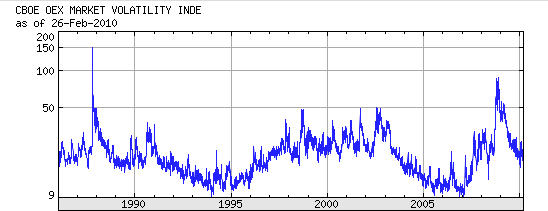VIX as a contrarian indicator
VIX is a measure of market volatility. Is volatility equal risk? Most people and finance textbook would tell you this is the case. Here I share with you two insightful pieces that surely offer you a fresh new perspective.
First, James Montier elaborates:
Nothing could be further from the truth. Volatility creates opportunity.

For instance, was the stock market more risky in 2007 or 2009? According to views of risk managers, 2007 was the less risky year, it had low volatility, which they happily fed into their risk models and concluded (falsely) that the world was a safe place to take risk. In contrast, these very same risk managers were saying that the world was exceptionally risky in 2009, and that one should be cutting back on risk. This is, of course, the complete opposite of what one should have been doing. In 2007, the evidence of a housing/credit bubble was plain to see, this suggested risk, valuations were high, it was time to scale back exposure. In 2009, bargains abounded, this was the perfect time to take ‘risk’ on, not to run away. Risk managers are the sorts of fellows that lend out umbrellas on fine days, and ask for them back when it starts to rain.
Second, Wall Street Journal has a wonderful piece with the similar idea —extreme low volatility often implies high risk ahead; and extreme high volatility often comes with huge opportunities.
The stock market’s most closely followed volatility index dropped this past week to its lowest level in nearly two years. Some investors who study volatility believe low readings are a bullish indicator for stocks. Historically, the market has tended to rise as volatility falls, and vice versa.
So the latest numbers are a surefire buy signal, right? Not necessarily. Dig a little deeper and you might even spot a contrarian indicator telling you to sell.
The Chicago Board Options Exchange’s volatility index, or VIX, is a gauge of investor sentiment. But its predictive power is limited to tallies of trades that have been made in the past. “The VIX is an important tool,” says Ben Londergan, co-chief executive of Group One Trading. “But it’s not the be-all and end-all factor to time your entrances and exits to the market.”
…
If anything, the VIX is most useful as a contrarian indicator. When the index remains unusually high or low for an extended period of time, it can mean a major market change is in the offing. For instance, the VIX had trended downward, and stocks upward, for several years leading up to the Dow Jones Industrial Average’s record close on Oct. 9, 2007. Then the subprime meltdown sent stocks plummeting as a historic bear market took hold.
One year later, during the diciest moments of the financial crisis, the VIX spiked to a record high of 80, capping a yearlong rise. Then it reversed course and fell sharply as stock markets enjoyed their most dramatic rally in decades.
Right now the VIX isn’t pointing to a major market move, since it is just now settling into its historical range. Under normal circumstances, the index moves in a fairly narrow band, mostly between 10 and 20. Having drifted gently downward for months, the index now sits at 17.
The recent drop is partly the result of an unusually steady stock market rally: In eight consecutive sessions over the past two weeks, stocks gained a total of just 2.2%, an amount that could easily be erased in one trading session.
So how can traders best make use of this oft-misunderstood index? By studying what is happening in the futures market. Professional investors have traded futures contracts on the VIX since 2004. When the futures are significantly different from the VIX itself, it is a signal that the index—and possibly the stock market—could soon reverse course. When the futures are significantly lower, it could be a bullish signal. When they are markedly higher, it could be bearish.
The latter is the case now. As of Friday’s close, the July futures on the VIX were trading at 23.25 and August futures at 23.40, considerably higher than the VIX’s 17. That suggests the pros are bracing for more volatility as the year wears on. If they turn out to be right, that could bode poorly for stocks.

